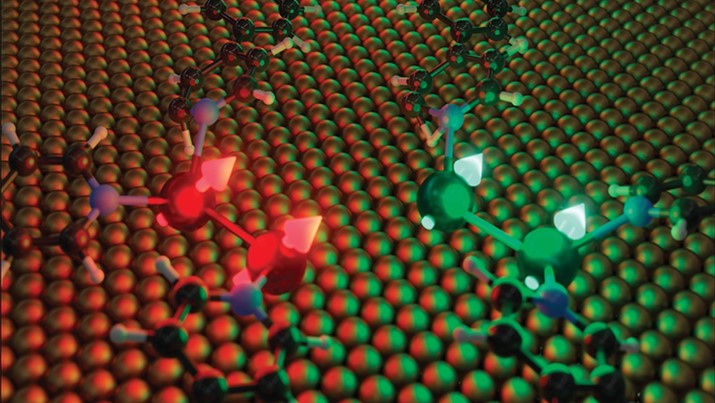Engineering periodic lanthanide networks by metal exchange
14.06.2022
 |
|
Redes metal-orgánicas de lantánidos dinucleares en una superficie. Imagen: Patricia Bondía. |
- IMDEA Nanociencia researchers demonstrate the tuning of the electronic and magnetic properties of stable dinuclear lanthanide metal–organic networks by metal exchange while preserving the same structural architecture.
- The exchange between Er and Dy metallic centers leads to a shift in the energy level alignment and allows the tailoring of both the intensity and orientation of magnetic anisotropy.
- This strategy could break new ground for the use of lanthanides in single-atom magnetism applications.
Madrid, June 14th, 2022. The stabilization of single atom magnets represents the ultimate limit on the reduction of storage devices. However, single standing atoms adsorbed on surfaces are not suitable for practical applications due to their high diffusion. The next step towards more realistic systems is the coordination of these atoms in metal-organic networks. Lanthanides (4f elements) possess properties that make them interesting for stabilizing magnetism. Their spin-orbit coupling is translated as a high magnetic anisotropy and a very stable magnetic state that could be protected from external perturbations.
In a recent study, published in Small, researchers at David Écija group (IMDEA Nanociencia), and co-workers have realized the tuning of the electronic and magnetic properties of dinuclear lanthanide metal–organic networks by metal exchange. While preserving the same structural architecture, the exchange between erbium (Er) and dysprosium (Dy) metallic centers leads to a shift in the energy level alignment and change in the intensity and orientation of the magnetic anisotropy. The networks are the same, but the properties change.
The results open perspectives for the design of periodic 2D materials with tailored optoelectronic and magnetic functionalities. The results have been published in Small, and featured in the back cover of the 22th issue.
The magnetism of the system was measured using the magnetic dichroism technique by Dr. Sofia Parreiras (MSCA fellow at IMDEA Nanociencia) in collaboration with the scientists of the BOREAS line at the ALBA Synchrotron. The work is a collaboration between researchers at IMDEA Nanociencia, ICMM-CSIC, ALBA Synchrotron, and the Condensed Matter Physics Center (IFIMAC, UAM), and has been cofunded by the ERC-AdG ELECNANO project to Prof. Écija, the "4f-Mag" project (MSCA-IF) to Dr. Parreiras and the Severo Ochoa Centre of Excellence Award to IMDEA Nanociencia in 2017.
Reference
Moreno, D., Parreiras, S.O., Urgel, J.I., Muñiz-Cano, B., Martín-Fuentes, C., Lauwaet, K., Valvidares, M., Valbuena, M.A., Gallego, J.M., Martínez, J.I., Gargiani, P., Camarero, J., Miranda, R. and Écija, D. (2022), Engineering Periodic Dinuclear Lanthanide-Directed Networks Featuring Tunable Energy Level Alignment and Magnetic Anisotropy by Metal Exchange. Small, 18: 2270117. DOI: 10.1002/smll.202270117.
Contact
Dr. David Écija
david.ecija [at]imdea.org
http://ecijalab.com
Twitter: @davidecijalab
IMDEA Nanociencia Dissemination and Communication Office
divulgacion.nanociencia [at]imdea.org
Twitter: @imdea_nano
Facebook: @imdeananociencia
Instagram: @imdeananociencia
Source: IMDEA Nanociencia





